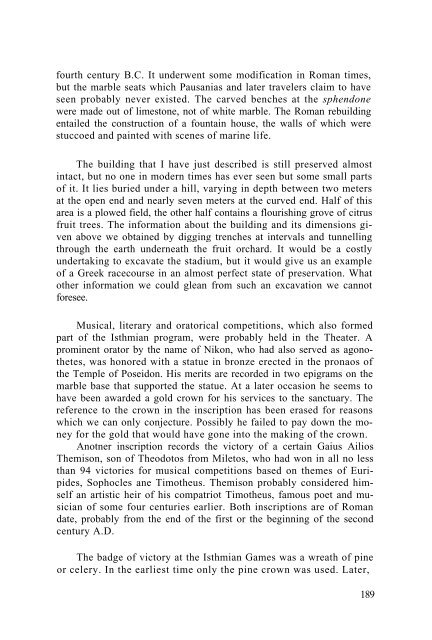download - IOA
download - IOA
download - IOA
Create successful ePaper yourself
Turn your PDF publications into a flip-book with our unique Google optimized e-Paper software.
fourth century B.C. It underwent some modification in Roman times,<br />
but the marble seats which Pausanias and later travelers claim to have<br />
seen probably never existed. The carved benches at the sphendone<br />
were made out of limestone, not of white marble. The Roman rebuilding<br />
entailed the construction of a fountain house, the walls of which were<br />
stuccoed and painted with scenes of marine life.<br />
The building that I have just described is still preserved almost<br />
intact, but no one in modern times has ever seen but some small parts<br />
of it. It lies buried under a hill, varying in depth between two meters<br />
at the open end and nearly seven meters at the curved end. Half of this<br />
area is a plowed field, the other half contains a flourishing grove of citrus<br />
fruit trees. The information about the building and its dimensions given<br />
above we obtained by digging trenches at intervals and tunnelling<br />
through the earth underneath the fruit orchard. It would be a costly<br />
undertaking to excavate the stadium, but it would give us an example<br />
of a Greek racecourse in an almost perfect state of preservation. What<br />
other information we could glean from such an excavation we cannot<br />
foresee.<br />
Musical, literary and oratorical competitions, which also formed<br />
part of the Isthmian program, were probably held in the Theater. A<br />
prominent orator by the name of Nikon, who had also served as agonothetes,<br />
was honored with a statue in bronze erected in the pronaos of<br />
the Temple of Poseidon. His merits are recorded in two epigrams on the<br />
marble base that supported the statue. At a later occasion he seems to<br />
have been awarded a gold crown for his services to the sanctuary. The<br />
reference to the crown in the inscription has been erased for reasons<br />
which we can only conjecture. Possibly he failed to pay down the money<br />
for the gold that would have gone into the making of the crown.<br />
Anotner inscription records the victory of a certain Gaius Ailios<br />
Themison, son of Theodotos from Miletos, who had won in all no less<br />
than 94 victories for musical competitions based on themes of Euripides,<br />
Sophocles ane Timotheus. Themison probably considered himself<br />
an artistic heir of his compatriot Timotheus, famous poet and musician<br />
of some four centuries earlier. Both inscriptions are of Roman<br />
date, probably from the end of the first or the beginning of the second<br />
century A.D.<br />
The badge of victory at the Isthmian Games was a wreath of pine<br />
or celery. In the earliest time only the pine crown was used. Later,<br />
189

















